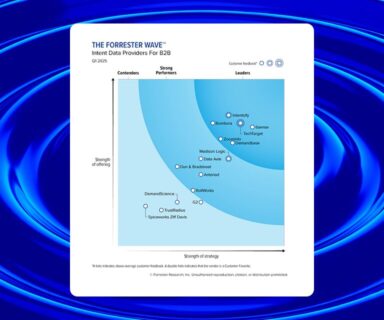 Today it’s hard to imagine a marketing or sales strategy that doesn’t include personas. It makes sense: know your target buyers’ typical profile, what’s made them tick historically, and then align your targeting, messaging & pitch on those attributes. But what if things change? What if we’re missing something with this diligent focus on / obsession with persona-driven marketing?
Today it’s hard to imagine a marketing or sales strategy that doesn’t include personas. It makes sense: know your target buyers’ typical profile, what’s made them tick historically, and then align your targeting, messaging & pitch on those attributes. But what if things change? What if we’re missing something with this diligent focus on / obsession with persona-driven marketing?
Personas were never real people
Don’t get me wrong – the concept, which dates back to the mid-1990’s, is logical and sound — but in today’s B2B technology environment, it’s actually only the start of the process necessary to ultimately drive closed-won revenue. When OgilvyOne pioneered “day-in-the-life archetype descriptions”, the idea was extremely useful: create imaginary or fictional characters to represent customers who share your company’s values or who are high fit targets to potentially buy from you. This high-level bucketing approach is useful for crafting general messaging and even for doing some product development. But because we’ re talking about either fictional representations or at least broad generalizations, when we go to take action on them in real life, especially in a dynamic market like right now, problems can arise. When we look to target and interact with the actual real people who are as dimensional and varied as the world we live in, generalizations cause some obvious problems.
Markets change
If we jump our time machine forward to the 2000’s when persona-driven marketing really took off, enterprise technology was very siloed. From a targeting perspective, it was effective to understand and focus on the very specialists in clearly defined spaces. For example, if a physical headquarters needed to prevent unauthorized access to their intellectual property, a firewall, data encryption and perhaps strong password policies might be enough to solve the problem. Naturally, the Network Manager or Security Lead would have been the more productive targets to concentrate on rather than a Backup Admin or Software Developer. And every hour spent targeting and prospecting specialists or ideal personas efficiently delivered more pipeline because it concentrated marketing and sales efforts on people with very specific departmental and functional responsibilities. But as technology has evolved, so have needs, and with them, roles, responsibilities, and more.
Change accelerates
Fast forward to now: Even pre-pandemic, the approach that same organization would use to protect its intellectual property has changed dramatically. Their data is now in the cloud, with one or more providers, in the applications (both cloud & on premises), in employee devices, contractors access it wherever they are, and so on. It’s no longer just trade secrets they have to protect. And it’s not just what we typically think of as ‘data’ because it now includes software code, applications & operating systems, personally identifiable information (PII) about customers, financial statements, physical infrastructure and the like.
Roles, responsibilities and teams are evolving
As technology changes, the people and teams involved with that technology also change. The familiar titles who a few short years ago may have been responsive to your product pitch are now often thinly spread across a complex range of priorities that span legacy departmental responsibilities to multiple different areas of interwoven infrastructures. Similarly, personas who never prioritized security in the past, now cite security features as top requirements for the purchases in their span of control. Cloud & infrastructure teams know that the ‘Shared Responsibility’ model requires businesses – not the cloud provider – to secure specific elements of their cloud deployments & workloads. These decisions might involve architecture shifts impacting the network, business continuity needs and so on. To accomplish the work, they must collaborate with experts in many areas to come up with forward-looking solutions.
Now, multiply this situation across the full IT stack (including areas I cover like Application Security & DevSecOps, secure remote access, cloud security & cloud posture management, etc.) and you can start to visualize the impact on simple persona-based targeting models: In reality, today’s buying groups cross over many different groups of people and areas of expertise and comprise very different titles than those represented in historical persona models.
Your personas must change with the times
Cloud and digital transformation has changed how buyers buy. Decisions are increasingly done by committees or hybrid pods of cross-departmental representatives. The old days of focusing only on like-minded, concentrated specialists, akin to fish in a barrel, are no more. LOB often steers or authorizes purchases; junior team members are tapped for greater responsibility with a “next person up” philosophy; and entire disciplines like DevSecOps are focused on responding to these changes. Marketers & sellers have a more distributed landscape of potential influencers they must navigate and influence or else they will miss these opportunities. Add pandemic budget, staffing and personnel disruption into the mix and the challenge becomes that much harder.
Ask yourself: How long has it been since you re-examined your personas in light of market evolution? Suppose the persona you’ve focused on has been recently redeployed – does that really mean a project isn’t happening? According to our latest TechTarget purchase process survey, 40% of enterprise technology buyers describe decision-making as more distributed than ever before and insight into confirmed projects through the first half of 2020 shows that confirmed buyers are considering nearly 50% fewer vendors than they did pre-pandemic. (Source: TechTarget Qualified Sales Opportunities service)
At the same time, our purchase intent data proves there’s real business opportunity still happening every day. To succeed in these realities, marketing and sales teams need to identify and engage real demand earlier and then manage it better across the goal line. If your persona models – and therefore your title and function-based targeting — don’t reflect how your markets have evolved, you will likely miss the chance to identify many of these deals. The time to update your persona and targeting thinking is now. Here are some ways to proceed.
New approaches to consider
Our clients are finding it helpful to think through scenarios like this: In a critical cloud migration project, who has more motivation to ensure both secure and on-time completion — a technical project manager with responsibility for that deployment or an already overworked security professional with a dozen other equally important priorities competing for her attention? As marketers and sellers, your teams need as many inroads as possible to a potential deal. Now more than ever, the stakeholders you’d historically least expect can become the champions you need to bring more attention to the value in your solutions. And by expanding your engagement efforts to more of the areas impacted by your solution, you’ll be able to do a much better job engaging silent stakeholders that with a more legacy approach could otherwise blindside you late in the game. Today’s businesses are purchasing technology to be more agile, nimble and opportunistic. That involves more people, in different roles, than many legacy persona-based targeting models were built to address. By re-adjusting your targeting for today’s market and today’s situations, you’ll put your organization in a better position to compete for business and defend its turf at the same time.



